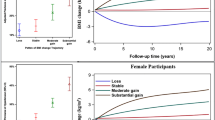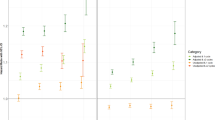Abstract
Objectives:
Although some prospective cohort studies have shown that baseline BMI is positively associated with a future incident risk for hypertension, these studies do not account for weight changes during the observation period. Therefore, it is not evident whether future incident risk for hypertension in obese, non-hypertensive people increases when their weight remains stable. We examined the association between long-term weight stability and risk for developing hypertension.
Methods:
A total of 5201 Japanese male workers aged 30–59 years underwent health checkups in 2002 and were followed through 2006. To consider transitions in covariates during the follow-up period, we used a time-dependent covariate Cox proportional hazard model to compute the relative risks (RRs) of incident hypertension. Furthermore, as a complementary analysis, we restricted the data to individuals whose BMI remained unchanged (±5% of baseline BMI) during the follow-up and compared the RRs between BMI categories.
Results:
During the follow-up, there were 899 newly diagnosed cases of hypertension among the 5201 men (14 888 person-years). Mean change in BMI during the follow-up period of all subjects was 0.2±1.1 kg/m2 (range: −6.6 to 6.3 kg/m2). The multivariate RRs for hypertension increased as BMI increased when we applied the time-dependent covariate Cox proportional hazard model. The complementary analysis showed that the multivariate RR (confidence interval) within the ⩾27.0 kg/m2 BMI category was 1.43 (1.16–1.77) times higher than the reference of 23.0–24.9 kg/m2, whereas the RR for the <21.0 kg/m2 BMI category was 0.63 (0.51–0.79) times lower than the reference.
Conclusions:
A higher baseline BMI increases future incident risk for hypertension even when there has been no major weight increase. Weight management should be encouraged for obese, non-hypertensive people to prevent future hypertension.
This is a preview of subscription content, access via your institution
Access options
Subscribe to this journal
Receive 12 print issues and online access
$259.00 per year
only $21.58 per issue
Buy this article
- Purchase on Springer Link
- Instant access to full article PDF
Prices may be subject to local taxes which are calculated during checkout


Similar content being viewed by others
References
Staessen JA, Wang JG, Thijs L . Cardiovascular protection and blood pressure reduction: a meta-analysis. Lancet 2001; 358: 1305–1315.
Chobanian AV, Bakris GL, Black HR, Cushman WC, Green LA, Izzo Jr JL et al. Seventh report of the Joint National Committee on Prevention, Detection, Evaluation, and Treatment of High Blood Pressure. Hypertension 2003; 42: 1206–1252.
Ueshima H, Zhang XH, Choudhury SR . Epidemiology of hypertension in China and Japan. J Hum Hypertens 2000; 14: 765–769.
Klag MJ, Whelton PK, Randall BL, Neaton JD, Brancati FL, Ford CE et al. Blood pressure and end-stage renal disease in men. N Engl J Med 1996; 334: 13–18.
MacMahon S, Peto R, Cutler J, Collins R, Sorlie P, Neaton J et al. Blood pressure, stroke, and coronary heart disease. Part 1, Prolonged differences in blood pressure: prospective observational studies corrected for the regression dilution bias. Lancet 1990; 335: 765–774.
Shuger SL, Sui X, Church TS, Meriwether RA, Blair SN . Body mass index as a predictor of hypertension incidence among initially healthy normotensive women. Am J Hypertens 2008; 21: 613–619.
Pang W, Sun Z, Zheng L, Li J, Zhang X, Liu S et al. Body mass index and the prevalence of prehypertension and hypertension in a Chinese rural population. Intern Med 2008; 47: 893–897.
Nguyen TT, Adair LS, He K, Popkin BM . Optimal cutoff values for overweight: using body mass index to predict incidence of hypertension in 18- to 65-year-old Chinese adults. J Nutr 2008; 138: 1377–1382.
Nemesure B, Wu SY, Hennis A, Leske MC . The relationship of body mass index and waist-hip ratio on the 9-year incidence of diabetes and hypertension in a predominantly African-origin population. Ann Epidemiol 2008; 18: 657–663.
Kawada T, Morihashi M, Ueda H, Sirato T . Body mass index of 23 or more is a risk factor for hypertension and hyperlipidemia in Japanese workers. Percept Mot Skills 2007; 104 (3 Part 1): 733–738.
Gelber RP, Gaziano JM, Manson JE, Buring JE, Sesso HD . A prospective study of body mass index and the risk of developing hypertension in men. Am J Hypertens 2007; 20: 370–377.
Kawada T . Body mass index is a good predictor of hypertension and hyperlipidemia in a rural Japanese population. Int J Obes Relat Metab Disord 2002; 26: 725–729.
Chen PC, Sung FC, Su TC, Chien KL, Hsu HC, Lee YT . Two-year change in body mass index and subsequent risk of hypertension among men and women in a Taiwan community. J Hypertens 2009; 27: 1370–1376.
Williams PT . Increases in weight and body size increase the odds for hypertension during 7 years of follow-up. Obesity (Silver Spring) 2008; 16: 2541–2548.
Truesdale KP, Stevens J, Cai J . Effect of 3-year weight history on blood pressure: the atherosclerosis risk in communities study. Obesity (Silver Spring) 2008; 16: 1112–1119.
Yang G, Xiang YB, Zheng W, Xu WH, Zhang X, Li HL et al. Body weight and weight change in relation to blood pressure in normotensive men. J Hum Hypertens 2007; 21: 45–52.
Juhaeri, Stevens J, Chambless LE, Tyroler HA, Rosamond W, Nieto FJ et al. Associations between weight gain and incident hypertension in a bi-ethnic cohort: the Atherosclerosis Risk in Communities Study. Int J Obes Relat Metab Disord 2002; 26: 58–64.
Ishikawa-Takata K, Ohta T, Moritaki K, Gotou T, Inoue S . Obesity, weight change and risks for hypertension, diabetes and hypercholesterolemia in Japanese men. Eur J Clin Nutr 2002; 56: 601–607.
Huang Z, Willett WC, Manson JE, Rosner B, Stampfer MJ, Speizer FE et al. Body weight, weight change, and risk for hypertension in women. Ann Intern Med 1998; 128: 81–88.
D’Agostino RB, Lee ML, Belanger AJ, Cupples LA, Anderson K, Kannel WB . Relation of pooled logistic regression to time dependent Cox regression analysis: the Framingham Heart Study. Stat Med 1990; 9: 1501–1515.
Fisher LD, Lin DY . Time-dependent covariates in the Cox proportional-hazards regression model. Annu Rev Public Health 1999; 20: 145–157.
Cox DR, Oakes D (eds). Analysis of Survival Data. Chapman and Hall: New York, 1984.
Matsuo T, Sairenchi T, Iso H, Irie F, Tanaka K, Fukasawa N et al. Age- and gender-specific BMI in terms of the lowest mortality in Japanese general population. Obesity (Silver Spring) 2008; 16: 2348–2355.
Hozawa A, Okamura T, Oki I, Murakami Y, Kadowaki T, Nakamura K et al. Relationship between BMI and all-cause mortality in Japan: NIPPON DATA80. Obesity (Silver Spring) 2008; 16: 1714–1717.
Cantor AB . SAS Survival Analysis Techniques for Medical Research, 2nd edn. SAS Institute Inc: Cary, NC, 2003.
Neter JE, Stam BE, Kok FJ, Grobbee DE, Geleijnse JM . Influence of weight reduction on blood pressure: a meta-analysis of randomized controlled trials. Hypertension 2003; 42: 878–884.
National Heart L and Blood Institute. The sixth report of the joint national committee on prevention, detection, evaluation, and treatment of high blood pressure. Arch Intern Med 1997; 157: 2413–2446.
Pi-Sunyer X . Body mass index as a risk factor for incident hypertension. Nat Clin Pract Endocrinol Metab 2007; 3: 742–743.
Omvik P . How smoking affects blood pressure. Blood Press 1996; 5: 71–77.
Stamler R, Stamler J, Gosch FC, Civinelli J, Fishman J, McKeever P et al. Primary prevention of hypertension by nutritional-hygienic means. Final report of a randomized, controlled trial. JAMA 1989; 262: 1801–1807.
Hu G, Barengo NC, Tuomilehto J, Lakka TA, Nissinen A, Jousilahti P . Relationship of physical activity and body mass index to the risk of hypertension: a prospective study in Finland. Hypertension 2004; 43: 25–30.
Author information
Authors and Affiliations
Corresponding author
Ethics declarations
Competing interests
The authors declare no conflict of interest.
Rights and permissions
About this article
Cite this article
Matsuo, T., Sairenchi, T., Suzuki, K. et al. Long-term stable obesity increases risk of hypertension. Int J Obes 35, 1056–1062 (2011). https://doi.org/10.1038/ijo.2010.226
Received:
Revised:
Accepted:
Published:
Issue Date:
DOI: https://doi.org/10.1038/ijo.2010.226
Keywords
This article is cited by
-
Body mass index, abdominal fatness, and hypertension incidence: a dose-response meta-analysis of prospective studies
Journal of Human Hypertension (2018)
-
Relations of body weight status in early adulthood and weight changes until middle age with hypertension in the Chinese population
Hypertension Research (2016)
-
What is the evidence base for diagnosing hypertension and for subsequent blood pressure treatment targets in the prevention of cardiovascular disease?
BMC Medicine (2015)
-
Development of a risk prediction model for incident hypertension in a working-age Japanese male population
Hypertension Research (2015)



